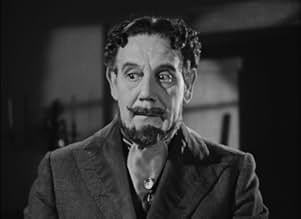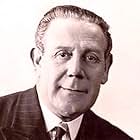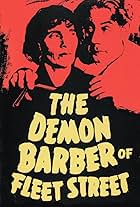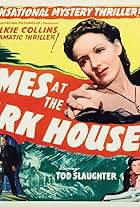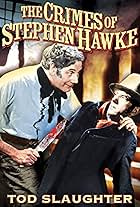Ajouter une intrigue dans votre langueSet in France in 1880. A series of murders is attributed to a Wolf Man.Set in France in 1880. A series of murders is attributed to a Wolf Man.Set in France in 1880. A series of murders is attributed to a Wolf Man.
- Réalisation
- Scénario
- Casting principal
Wallace Evennett
- Professor le Blanc
- (as Wallace Evenett)
Bill Shine
- Pierre
- (as Billy Shine)
Avis à la une
In 1880, the criminal called The Face is responsible for a murderous rampage in France. When the Brisson Bank is robbed in Paris and the employee Michelle is murdered, the wealthy Chevalier Lucio del Gardo (Tod Slaughter) is the only chance to save the bank. Chavalier proposes to the owner M. de Brisson (Aubrey Mallalieu) to deposit a large amount of gold, but in return he would like to marry his daughter Cecile (Marjorie Taylor). However, Cecile is in love with the efficient clerk Lucien Cortier (John Warwick) that belongs to the lower classes and refuses the engagement. In order to get rid off the rival, Chavalier uses evidences to incriminate Lucien, manipulating the incompetent Parisian chief of police.
"The Face at the Window" is dated and delightfully naive, but is also a great entertainment. The story has a despicable villain; the good guy is unfairly accused and has to prove his innocence; the heroine is extremely naive, but has strength to fight for her love; the chief of police is a complete stupid. Tod Slaughter performs another villain with his usual efficiency. My vote is seven.
Title (Brazil): "Um Vulto da Janela" ("A Face at the Window")
"The Face at the Window" is dated and delightfully naive, but is also a great entertainment. The story has a despicable villain; the good guy is unfairly accused and has to prove his innocence; the heroine is extremely naive, but has strength to fight for her love; the chief of police is a complete stupid. Tod Slaughter performs another villain with his usual efficiency. My vote is seven.
Title (Brazil): "Um Vulto da Janela" ("A Face at the Window")
This was a fun wolf man film. It is true that Tod Slaughter is quite a bit of a 'ham' (like Vincent Price) and it is his performance that made the film fun to watch. This movie is a good watch if you enjoy the classics and werewolf films. The film is a horror film but has touches of comedy in it tastefully done.
Who is "The Face at the Window"? We have two plausible suspects: Chevalier Lucio del Gardo (Tod Slaughter) and Lucien Cortier (John Warwick) but could it be someone else? Don't expect this film to be anything like "Werewolf of London" or "Wolf Man" -- this flick it a different story than either of two mentioned films.
This movie would make a great manatee' or a rainy day film. I quite enjoyed this movie.
7/10
Who is "The Face at the Window"? We have two plausible suspects: Chevalier Lucio del Gardo (Tod Slaughter) and Lucien Cortier (John Warwick) but could it be someone else? Don't expect this film to be anything like "Werewolf of London" or "Wolf Man" -- this flick it a different story than either of two mentioned films.
This movie would make a great manatee' or a rainy day film. I quite enjoyed this movie.
7/10
Forget Karloff & Lugosi. Forget Cushing & Lee, even Price and the Chaneys. Tod is king of horror for one very important reason - he quite evidently enjoys his work. This was the first Tod film I saw and - having heard so much about him prior to this - I feared disappointment. No worries. Despite the cardboard settings and woeful support cast, from the moment he strides masterfully in, we are in the capable hands of a classic film villain. The opening murder with the eerie wolf howl on the soundtracks sets the scene perfectly and then we are treated to an acting masterclass from the great man himself. Whether innocently acting the concerned friend, lecherously trying to sneak a kiss from the heroine, threatening his low-life confederates with a grisly end if they cross him or, worst of all, holding somewhat one-sided conversations with his demented foster brother, Tod holds the film together. The Chevalier is underplayed by Tod compared to Sweeney Todd - but seldom has one man wiggled his eyebrows to more sinister effect. It's a great pity that Universal studios didn't try to to entice him over for their classic horror cycle - Tod would've made a far more spirited Dracula than John Carradine in the later sequels and can't you just see him going toe to toe with Basil Rathbone's Sherlock Holmes. Shame nobody thought of putting him up against Arthur Wontner's in the UK. The double-exposure effects for the appearance of the "face" are well done for their time and the whole film compares favourably with the Universal classics of the period.
The production values are far higher than is normal for a British quota quickie of the period. The contrast between the spacious elegant rooms of the moneyed classes and the clutter of the Blind Rat - with a wealth of extras and charming Parisian detail such as the dancers - more than foreshadows the class-consciousness Hammer brought to its gothics a few decades later. So does the violent action with Lucien using an oil lamp to devastating effect - his disguise as "Renard" could have been a bit more convincing - and Tod making a sudden getaway by leaping from the window of the scientist's house and swimming the Seine to safety. John Warwick and Marjorie Taylor make an appealing couple - although Warwick is no match for Eric Portman in the earlier melodramas - and George King is improving as a director with a tightly edited montage of tense faces as the "corpse" slowly stirs into action to write its incriminating message. Tod is less of a central figure with whom we are expected to side with - even through his setbacks - as Stephen Hawke and Sir Percival Glyde were, but is still a marvellously blackhearted villain, as seen in his unsporting behaviour at the duel with pistols with Lucien. This is his finest film.
The production values are far higher than is normal for a British quota quickie of the period. The contrast between the spacious elegant rooms of the moneyed classes and the clutter of the Blind Rat - with a wealth of extras and charming Parisian detail such as the dancers - more than foreshadows the class-consciousness Hammer brought to its gothics a few decades later. So does the violent action with Lucien using an oil lamp to devastating effect - his disguise as "Renard" could have been a bit more convincing - and Tod making a sudden getaway by leaping from the window of the scientist's house and swimming the Seine to safety. John Warwick and Marjorie Taylor make an appealing couple - although Warwick is no match for Eric Portman in the earlier melodramas - and George King is improving as a director with a tightly edited montage of tense faces as the "corpse" slowly stirs into action to write its incriminating message. Tod is less of a central figure with whom we are expected to side with - even through his setbacks - as Stephen Hawke and Sir Percival Glyde were, but is still a marvellously blackhearted villain, as seen in his unsporting behaviour at the duel with pistols with Lucien. This is his finest film.
Yes, this film is dated. Yes, it is muddled with every possible plot contrivance imaginable in a mystery-melodrama. But, this film stars one of the kings of the horror screen - a forgotten king named Tod Slaughter. And if you have never had the opportunity and privilege to see him on screen, then you are missing out on a pure cinematic joy. He is the hammiest of the hams with his eyes rolling incessantly, his mischievous leers, his over-pronounced dialogue, and his bombastic gestures. He makes Vincent Price look like an actor accustomed to giving understated performances. Plainly put - he is fun to watch! Slaughter was a British actor known primarily for his stage work but he made several pictures. As with all his films, he is the primary focal-point of attention, and A Face at the Window is no exception. This is a fun movie to watch and should make you a Tod Slaughter fan. The story of the movie is complicated and stretches credibility at times, but is to be taken in fun....that is apparent as soon as you see Slaughter say something and gesture about.
Tod Slaughter has to be one of the most reliably entertaining screen actors of the 30's. I've seen most of this guys films and he never disappoints. There's no doubt that his acting style is hammier than a hammy thing but there's nothing wrong with that surely? It takes considerable charisma and skill to overact as compellingly as Slaughter. This film follows a very similar narrative path to many of his other vehicles, i.e. Slaughter plays a rich pillar of the community who lives a double-life as an evil criminal, he lusts after a woman half his age who is not interested in him, so he sets about framing her fiancé with a crime he did not commit leaving the poor girl easy prey for him. Almost all his movies could be described thus. But it doesn't really seem to matter very much as Slaughter is always terrific as the leering cad and is easily the best thing about the films he stars in.
Slaughter's films were all Victorian melodramas first and foremost but this one definitely moves into more definite horror and even science fiction territory. The monster who is the face of the title is an effective looking baddie although he doesn't really get to do much and his presence in the movie doesn't make an awful lot of sense. But not to worry because, as I mentioned earlier, this is Slaughter's film and he delivers the goods as usual.
Slaughter's films were all Victorian melodramas first and foremost but this one definitely moves into more definite horror and even science fiction territory. The monster who is the face of the title is an effective looking baddie although he doesn't really get to do much and his presence in the movie doesn't make an awful lot of sense. But not to worry because, as I mentioned earlier, this is Slaughter's film and he delivers the goods as usual.
Le saviez-vous
- AnecdotesOne of over 200 titles in the list of independent feature films made available for television presentation by Advance Television Pictures announced in "Motion Picture Herald", 4 April 1942. At this time, television broadcasting was in its infancy, almost totally curtailed by the advent of World War II, and would not continue to develop until 1945-46. Because of poor documentation (feature films were often not identified by title in conventional sources) no record has yet been found of its initial television broadcast. It's earliest documented USA telecasts took place on American Broadcasting Company's short-lived First Nighter Theatre, aired in New York City Wednesday 15 November 1950 on WJZ (Channel 9), in Los Angeles Tuesday 28 November 1950 on KECA (Channel 13), in San Francisco Monday 4 December 1950 on KGO (Channel 7) and in Philadelphia Friday 30 March 1951 on Friday TV Thriller on WCAU (Channel 10).
- ConnexionsFeatured in Phantom Ferris Theatre: Face at the Window (1959)
Meilleurs choix
Connectez-vous pour évaluer et suivre la liste de favoris afin de recevoir des recommandations personnalisées
- How long is The Face at the Window?Alimenté par Alexa
Détails
- Date de sortie
- Pays d’origine
- Langues
- Aussi connu sous le nom de
- Um Vulto na Janela
- Lieux de tournage
- Société de production
- Voir plus de crédits d'entreprise sur IMDbPro
- Durée1 heure 7 minutes
- Couleur
- Rapport de forme
- 1.37 : 1
Contribuer à cette page
Suggérer une modification ou ajouter du contenu manquant

Lacune principale
By what name was The Face at the Window (1939) officially released in India in English?
Répondre





